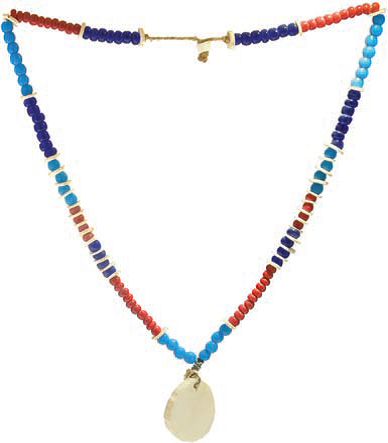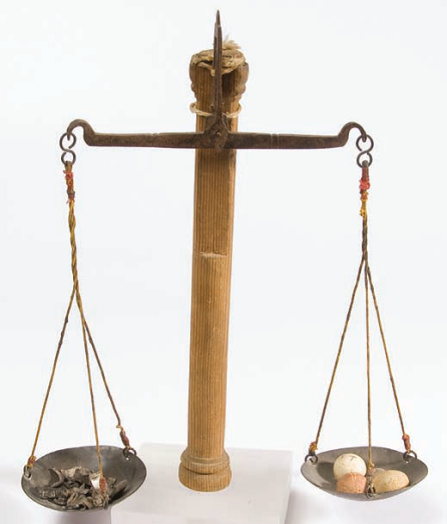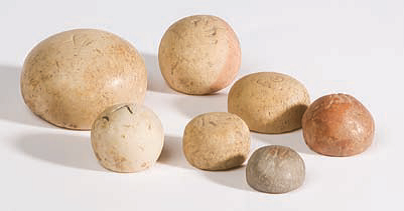Part 1 - Currency Exhibition
Selected items from the currency exhibit
The development of money, barter, invention of money, and currency of the Land of Israel
First – what is money?
It doesn’t matter what money is made from or what form it takes. What is important is that it answers three main needs: It must be exchangeable, it must serve to measure value and compare the value of goods, and it must serve as a tool for savings.
These are possible only if people believe in the money. Bottom line, money can be anything that people will believe in and agree to receive as payment. In addition, it is important that it also be resilient in various climate conditions, easy to carry, easy to divide, and serve as a means of payment that will maintain its value.
Part 1 – Barter and pre-currency
Barter – This was also once a form of payment
In the ancient world, before the invention of money, trade was generally carried out through exchanging one item for another, or in other words – barter. This form of trade has its advantages, but also many disadvantages. The latter include the fact that it was confusing, and required coordination between the wishes and needs of both parties to each transaction, which did not always mesh. In addition, it was necessary to conduct negotiations over the value of the means of payment in each transaction.
Barter continued in many places in the world even after money was introduced, and throughout history. Common means of payment included wheat, salt, metal bracelets, shells, beads, and more.
The development of money, barter, invention of money, and currency of the Land of Israel
First – what is money?
It doesn’t matter what money is made from or what form it takes. What is important is that it answers three main needs: It must be exchangeable, it must serve to measure value and compare the value of goods, and it must serve as a tool for savings.
These are possible only if people believe in the money. Bottom line, money can be anything that people will believe in and agree to receive as payment. In addition, it is important that it also be resilient in various climate conditions, easy to carry, easy to divide, and serve as a means of payment that will maintain its value.
Part 1 – Barter and pre-currency
Barter – This was also once a form of payment
In the ancient world, before the invention of money, trade was generally carried out through exchanging one item for another, or in other words – barter. This form of trade has its advantages, but also many disadvantages. The latter include the fact that it was confusing, and required coordination between the wishes and needs of both parties to each transaction, which did not always mesh. In addition, it was necessary to conduct negotiations over the value of the means of payment in each transaction.
Barter continued in many places in the world even after money was introduced, and throughout history. Common means of payment included wheat, salt, metal bracelets, shells, beads, and more.
A block of salt
Did you know?
The English word “salary” comes from the Latin word “sal”, which means “salt”, since salt was used as a means for paying wages to soldiers of the Roman Legion.
That is also the source for the phrase “worth his salt”.
The English word “salary” comes from the Latin word “sal”, which means “salt”, since salt was used as a means for paying wages to soldiers of the Roman Legion.
That is also the source for the phrase “worth his salt”.

Alternative currency
Alternative currency in the form of plated knives, China

Means of payment
Means of payment in the form of a coiled metal bracelet from Nigeria.

Glass beads and ostrich eggs
A colorful chain of glass beads and ostrich eggs, Kenya

Cowrie (Cypraea) shells
Cowrie (Cypraea) shells, Rhodesia (now Zimbabwe).

Before the invention of money:
In ancient societies, before the invention of money, trade was mainly through the barter system – the exchange of goods for goods. Trade was conducted mainly using food products, and the value of the goods in each trade was set by negotiation between the parties.
The complex nature of this method led to the use of precious metals, mainly silver, as a means of tradable payment, which made trade much easier.
The advanced stage of barter prior to the invention of coins included the use of pieces of silver that were weighed on scales against weight stones. These pieces of silver were in use from the Bronze Age throughout the Iron Age, and even later.
A scale for weighing precious metals against weights
Did you know?
The term “Shekel” was used as a biblical unit of weight weighing 11.35 grams. This was the currency used by Abraham in purchasing the Cave of Machpela from Efron the Hittite, for 400 shekels of silver (about 4.5 kg of silver).
“…and Abraham weighed to Ephron the silver, which he had named in the hearing of the children of Heth, four hundred shekels of silver, at the going merchants' rate.” – Genesis 23:16.
The complex nature of this method led to the use of precious metals, mainly silver, as a means of tradable payment, which made trade much easier.
The advanced stage of barter prior to the invention of coins included the use of pieces of silver that were weighed on scales against weight stones. These pieces of silver were in use from the Bronze Age throughout the Iron Age, and even later.
A scale for weighing precious metals against weights
Did you know?
The term “Shekel” was used as a biblical unit of weight weighing 11.35 grams. This was the currency used by Abraham in purchasing the Cave of Machpela from Efron the Hittite, for 400 shekels of silver (about 4.5 kg of silver).
“…and Abraham weighed to Ephron the silver, which he had named in the hearing of the children of Heth, four hundred shekels of silver, at the going merchants' rate.” – Genesis 23:16.

Pieces of jewelry and shards of silver
Pieces of jewelry and shards of silver were used as means of payment during the later Canaanite period (14th-13th centuries BCE).

Stone weights
Stone weights of the shekel series from the First Temple period, 8th-7th centuries BCE.
